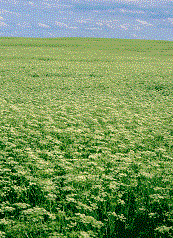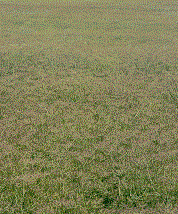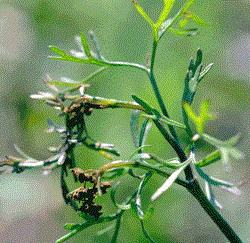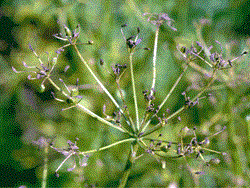
In Saskatchewan, coriander and caraway are affected by a blight that can cause severe losses in these crops. In the diseased caraway field in Figure 2, yield loss from blight was over 90 per cent. The disease is also called blossom blight because it mainly kills the flowers.

Cause
The most important cause of blight in caraway is an Ascochyta species (sp), while in coriander it is an Aureobasidium sp. Ascochyta sp. will also cause blight on coriander, while Aureobasidium sp. will cause blight on caraway. Additional fungal species can cause the same disease on both crops and these are: Fusarium avenaceum, F. poae, F. culmorum, F. equiseti, F. sporotrichioides, F. graminearum, Botrytis cinerea and Sclerotinia sclerotiorum. The occurrence of persistent wet conditions during flowering could result in any one of these fungi-causing blight.
Field Scouting

The best time to scout crops for this disease is during flowering. Depending upon the stage of flowering, a healthy field will show the whitish to whitish-pink coloration of the flowers interspersed with the bright green growth of healthy stems, leaves and seeds. Depending upon disease severity, a blighted field may have scattered small patches of brown areas to the whole field being brown. Note the difference in colour between the healthy and diseased caraway fields in Figures 1 and 2. Distinct patches of disease may indicate points of inoculation that originated from seed. When the disease is severe a field may turn brown in a few days. This browning in a crop is mainly due to the death of growing tips, flowers and umbels. This damage is illustrated in Figures 3 and 4. In coriander, note the browning and death of the emerging umbels containing the young flowers. In caraway, note the dieback of the small flowers and young seeds. Later in the season when plants are beginning to mature it may be difficult to recognize a diseased field aside from the reduced seed production.

There is no simple method for the control of blight. The currently grown types or cultivars show no resistance to blight. Once blight is established in a field or on a farm it will be there for a long time. The following suggestions may lower the risk of severe damage. Weather remains an unpredictable but very important factor, as a prolonged moist period during flowering is very conducive to disease development.
Continuous cropping: Because the disease is more severe in older crops there is a high risk of damage if these crops are grown continuously. For instance, a two-year-old caraway field with a trace of blight will likely be a severely-damaged field in the third year.
Coriander under-seeded to caraway: The former practice of under-seeding coriander with caraway could favour disease development in caraway when it produces seed in the second year, as the same pathogens can affect both crops.
Suggested Control Measures
- Crop rotation - Crop rotation is another control measure, but there is no data to suggest how long the interval should be between crops. An estimate would be a two to five-year period between the same crop. There are many factors that determine how long the causal agents will survive in a field. For instance, coriander persists as a weed for a long time, which could allow the disease to survive in a field so a longer interval between crops may be needed. Another consideration is that Fusarium spp., which can cause blight in coriander and caraway also cause fusarium head blight in wheat. If fusarium head blight was severe in a wheat field it might be appropriate not to seed that field to coriander or caraway the following year.
- Field location - Give some thought to field location because a severely diseased crop is a source of inoculum for crops planted in adjacent fields the following year. The inoculum of these diseases can spread across a road allowance, but it is unknown if they can spread further.
- Disease-free seed - Using seed from a field with no disease should reduce the spread to new fields or new areas. Caraway seed could be tested for the presence of pathogens, but coriander seed is usually heavily contaminated with saprophytes so a seed test may be inconclusive to determine the presence of pathogens.
- Fungicide control - Although fungicide sprays have shown some promise, none are currently registered for use on caraway. Quadris is registered for control of blossom blight on coriander. Check the chemical label for crop timing and rates.
The information provided came mainly from a project funded by the Agriculture Development Fund, Saskatchewan Ministry of Agriculture to L. Duczek and A. Slinkard.
